
SELECTION OF THE STIMULATION METHOD 20
The selection of the method of stimulation over the su jok points depends on the disease’s seriousness and the size of the correspondence zone that will be used.
More serious the disease, more lasting and powerful must be the healing impulses needed for its overcoming.
With diseases that are not so serious a soft way of stimulation of the pain su jok points can be used. For instance for the treatment of a mild case of a cold it is not necessary needles to be used. Sufficient is the massage with a diagnostic probe or seed-therapy (magnets).
The more serious, acute and chronic diseases require powerful and lasting healing impulses, created with moxa, needles or combination of different methods of stimulation. For example warming up with moxa and placing of magnets for the period till the next procedure or needle stimulation plus a recurrent general massage with a su jok massager.
When you choose a stimulation method you should have in mind that if you select a powerful method to treat not so serious disease you will simply cure it faster, but if you choose too soft method by a serious disease you won’t have any success. So it is better you to get reinsured.
In small correspondence zones it is better to use a method of stimulation, concentrated on a smaller area.
The correspondence zones in the “Insect“ system are smaller than the correspondence zones in the Main correspondence system. That’s why in this case it is better to use needles, minimoxa, seeds, magnets or a diagnostic probe massage. Moxa cigars are more suitable to be used in the Main correspondence system. Cigars can be also used in the „Insect“ system if the affected body area and its projection are large.
PROCEDURE PARAMETERS
NUMBER AND FREQUENCY
The procedures number depends on the nature and seriousness of the disease. They are done every day, no matter what time of the day, but not more than 14 in one course of treatment.
If there is time and patience, it is possible 2 procedures to be made a day (in the morning and in the evening). Thus the healing process speeds up.
The treatment must continue 2-3 procedures after the symptoms of the disease have disappeared – this serves as a rule that must be always observed. Otherwise, it is possible the disease to „come back”
Normally with recently discovered acute diseases 3 to 5 procedures daily are enough.
Often the disease’s symptoms disappear in the first minutes and sometimes in the first seconds of the first procedure. Notwithstanding, 2-3 procedures more are needed for the healing effect to be strengthened.
Sometimes with chronic diseases a course treatment is necessary to be done. 2 to 6 courses consisting of 10-14 procedures are made with a break of 1-2 weeks between them. If the disease worsens during this period, the procedures should be made every day, if it is not acute – at intervals of one-two days.
Note: The breaks between the treatment courses are made so that the used pain points can rest, because their long every day stimulation decreases their effectiveness. That’s the reason the prescriptions given in this book to suggest succession of the pain points stimulation in different correspondence zones of the diseased organ.
Note: The breaks between the treatment courses are made so that the used pain points can rest, because their long every day stimulation decreases their effectiveness. That’s the reason the prescriptions given in this book to suggest succession of the pain points stimulation in different correspondence zones of the diseased organ.
DURATION
The duration of a procedure depends on the stimulation method and the number of the stimulated pain points or areas. Here we just want to give you some information about the duration of the main stimulation methods and we don’t include the time needed for the location of the pain points.
GENERAL STRENGTHENING MASSAGE WITH A MASSAGER: Usually two fingers are massaged with a ring and the entire hands and feet – with a spiral or cylinder, the aimed result is a powerful warming up of the skin. It takes 3-7 minutes altogether.
Usually two fingers are massaged with a ring and the entire hands and feet – with a spiral or cylinder, the aimed result is a powerful warming up of the skin. It takes 3-7 minutes altogether.
Usually two fingers are massaged with a ring and the entire hands and feet – with a spiral or cylinder, the aimed result is a powerful warming up of the skin. It takes 3-7 minutes altogether.
SEEDS (MAGNETIC STARS, MAGNETS):
The placing of the stimulators itself can take up to 20 minutes. From 1 to 6 points are used. Later on the pain points are massaged (when seeds or magnetic stars are used) for 1-2 minutes, 3-4 times a day.
DIAGNOSTIC PROBE MASSAGE: To be created a stable healing impulse the pain point should be massaged till the pain disappears and a warm sensation takes its place – for about 15 to 30 minutes.
To be created a stable healing impulse the pain point should be massaged till the pain disappears and a warm sensation takes its place – for about 15 to 30 minutes.
To be created a stable healing impulse the pain point should be massaged till the pain disappears and a warm sensation takes its place – for about 15 to 30 minutes.
MOXA: The warming up of a point or area takes 20-30 minutes. Most often are warmed up 1-2
The warming up of a point or area takes 20-30 minutes. Most often are warmed up 1-2 su jok points or areas. This takes from 20 to 60 minutes altogether.
NEEDLES: The needles have to stay in the pain point not less than 30 minutes. The counting starts after the last needle is placed. The total duration of the procedure, together with the needle inserting is up to 50 minutes.
At first sight one procedure lasts long – sometimes more than an hour. But you can make it at leisure, while you are watching TV. The procedure is not boring and is made without causing inconveniences, with a nice movie, serving as a background. As a matter of fact if you make psychotherapeutic procedures in a hospital you would lose more time, and money, which is time again, because you have worked to earn it.

MAIN CORRESPONDENCE SYSTEM 1
MAIN CORRESPONDENCE SYSTEM
The hands and feet structure is almost identical with the structure of the human body. Forming a mental image it is sufficient to turn your thumbs up, with their adjoining areas of the palm, to see that the similarity to the human body is amazing and the correspondence zones of the organs and parts of the body appear clearly and logically.
- The thumb corresponds to the neck and head.
- The second and fifth fingers correspond to the upper limbs.
- The third and fourth fingers – to the lower limbs.
- The knuckles correspond exactly to the joints of the limbs.
- The palm, the foot and their backs – to the torso.
- The correspondence zones of the internal organs are located on the palm and foot, following the resemblance principle.
When a man falls ill one or more pain points (sujok acupoints) appear on the hands and feet in the correspondence systems of the diseased organ. The stimulation of these zones has a clear healing effect. This stimulation can be compared with the button pressure on a remote control panel. The button pressure sends to the diseased organ an impulse that starts the healing process. Besides the healing effect is extremely powerful and quick!
Note: The feet are put to more aggressive everyday pressure than the hands. Therefore the healing impulses created by the pain sujok points located on the feet are more effective.

PRIMARY AND SECONDARY ZONES OF CORRESPONDENCE 3
PRIMARY AND SECONDARY ZONES OF CORRESPONDENCE
The body has two vertical halves – left and right. In the same way, each correspondence system has left and right half, corresponding with the left and right body half.
- The position of the left and right half in the Main correspondence system is defined when your own hands (feet) are with fingers (toes) directed downwards. The palms (feet) are turned forward. Form a mental picture of the turned up thumb, together with its adjoining area of the palm (foot). As it is, on the right halves of the hands (feet) the right body half is projected and on the left halves – the left body half.
- The position of the left and right half in the “Insect” correspondence system is defined when your own hands (feet) are with fingers (toes) directed upwards. The palms (feet) are turned forward. As it is in the right halves of the fingers (toes) the right body half is projected and in the left halves – the left body half.
Example: The liver, gall, right leg, right arm, right eye, right ear etc. are organs located in the right body half. That is why their primary correspondence zones are on the right hand (foot) and their secondary correspondence zones are on the other side – on the left hand (feet).
Example: The heart, spleen, left leg, left arm, left ear, left eye etc. are in the left body half. That is why their primary correspondence zones are on the left hand (foot) and their secondary correspondence zones – on the right hand (feet).
The primary correspondence zones are closer to the organ they correspond with and may be that is the reason for their greater effectiveness. They have priority when you choose a zone for stimulation.
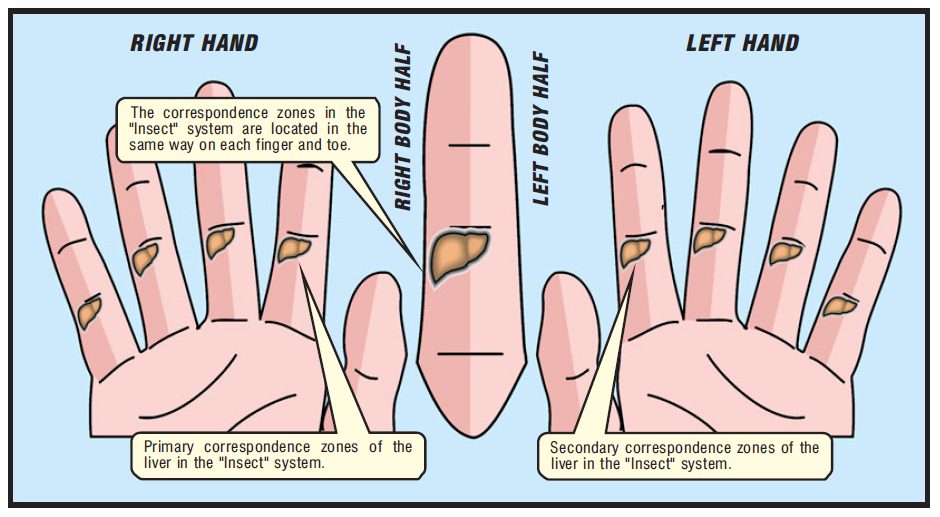


STRATIFICATION OF THE CORRESPONDENCE SYSTEMS 4
STRATIFICATION OF THE CORRESPONDENCE SYSTEMS
Namely the “Insect” correspondence system lies on this part of the Main system, projected on the fingers (toes).
As we mentioned above, correspondence systems are located on all independent parts of the body. But some independent parts of the body are part of other independent parts of the body. In this instance the hand (foot) as a whole is an independent part. Separately the fingers (toes) are independent parts too. Thereby a stratification of correspondence systems comes out – once on the entire hand (foot) and twice on each finger (toe) separately. This means that in one and the same area of the hands (feet) correspondence zones of different organs are projected.
Example: According to the Main correspondence system, the right foot is projected on the first phalanx of the right middle finger. But according to the “Insect” system the head is projected there.
In the same way stratification appears between some correspondence zones, which are components of the Main correspondence system. That is the case with the zones of the thoracic organs. On the hand the thorax is projected in the area of the palm, separated by the life line. When we form a mental picture of the turned thumb, together with the thumb we turn this part of the palm too. Then it is obvious that when the thumb is in normal position the zones of the organs, located in the thorax, overlap part of the organs, located in the abdominal area see image.

At first sight this stratification of correspondence systems and zones seems confusing but actually (related to the example) it only means that:
- If some of the head organs get diseased, for example the nose, a pain point will appear on the first phalanx of the right middle finger, according to the “Insect” system.
- If the nose and the foot get diseased at the same time, pain points will appear simultaneously on the first phalanx of the right middle finger, corresponding to the right foot after the Main correspondence system and on the nose after the “Insect” system.

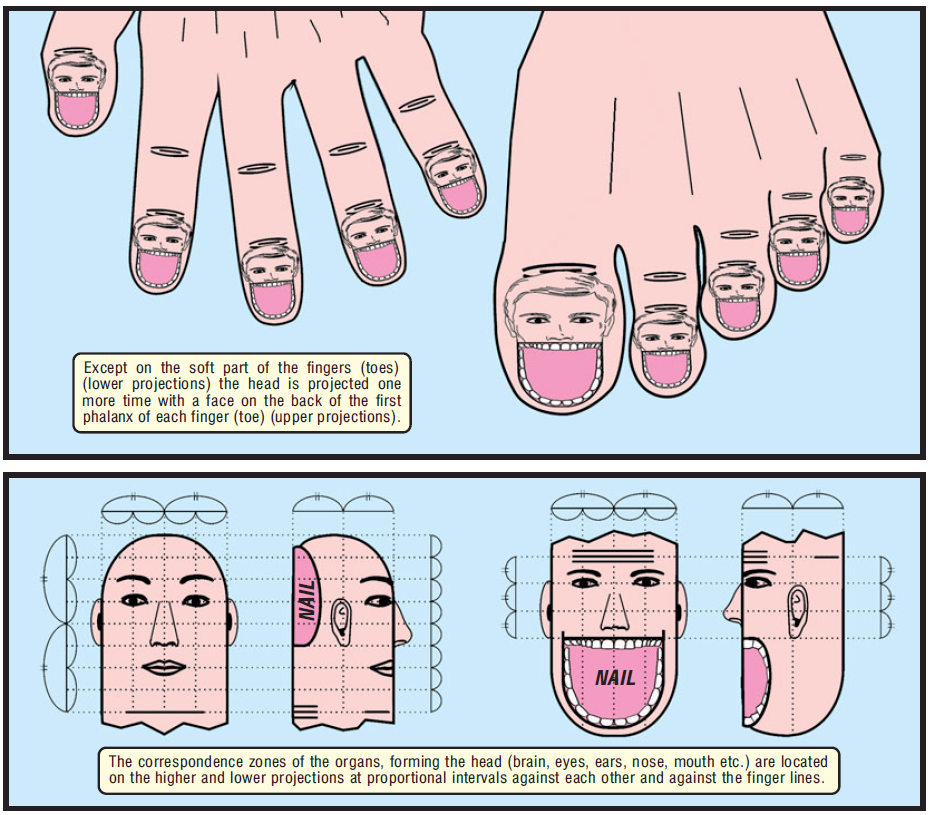
MULTIPLE PROJECTING OF THE HEAD 5
MULTIPLE PROJECTING OF THE HEAD
The head (brain) is the most important part of the human body. Here the control of all systems and organs forming the body is concentrated. The proper functioning of the whole organism and its health depends on the proper brain functioning. Because of the great significance of the brain in the both correspondence systems – Main system and “Insect” correspondence system the correspondence zones of the head are doubled.
- Once the head is projected on each finger and toe with a face, located on the soft part of the first finger (toe) phalanx – lower projection (see the illustrations above, illustrating the Main system and the “Insect” correspondence system,below two images.

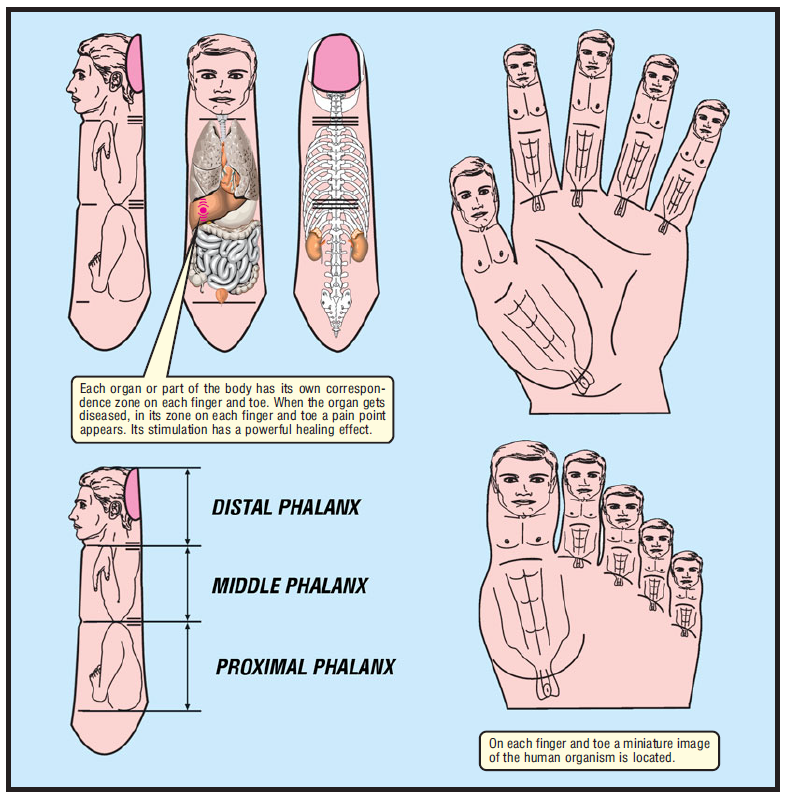
- Twice the head is projected on each finger and toe with a face, located on the back of the first finger (toe) phalanx – upper projection.
By both kinds of projections the correspondence zones of the organs, forming the head, are located at definite proportional intervals against each other and against the finger lines. For example on the lower projections of the head, the correspondence zones of the eyes are located three segments below from the finger (toe) tips. In the upper projections the zones of the eyes are located in one segment from the knuckle of the first phalanx.
The pain point stimulation of the both kinds of projections in the head – higher and lower, has the same healing effectiveness.
When you have cold it doesn’t matter whether you stimulate the pain points, appeared in the correspondence zones of the nose on the lower projections or on the higher ones. In both cases a healing impulse with the same strength and effectiveness will be generated.
The most important projections of the head are located on the thumbs.
Here coincide the lower and the upper projection of the head according to the both correspondence systems – the Main system and the “Insect” correspondence system. For that reason the healing impulses emitted by the pain points on the thumbs are more powerful than these of the other fingers (toes).
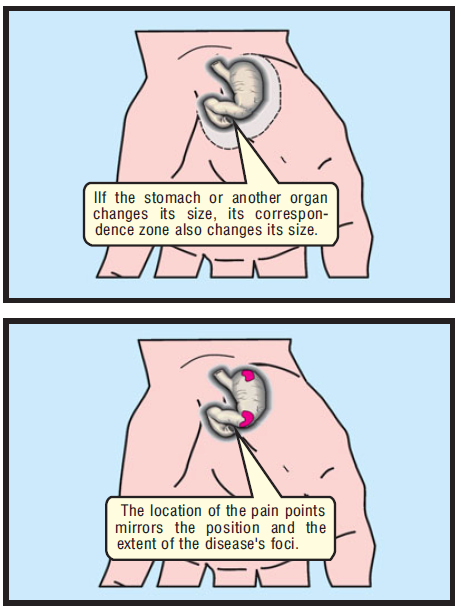
PROPORTIONALITY OF THE CORRESPONDENCE ZONES 6
PROPORTIONALITY OF THE CORRESPONDENCE ZONES
The shape of the correspondence zone is similar and proportional to the shape of the organ it corresponds with. It follows the changes that occur in the position and shape of the organ itself.
Example: When a person puts on too much weight, the stomach becomes distended. Then the correspondence zone of the stomach expands too and becomes dislocated against the zones of the other organs, proportional to the shape and position change of the stomach itself. In such a way – as little images, the correspondence systems and zones mirror the alterations in the organism state.
When some organ gets diseased the position of the pain points, appearing on its correspondence zone, mirrors the location and the size of the disease’s focus on the ill organ.
Example: If you have a gastric ulcer in the upper part of the stomach, pain points appear in the upper part of its correspondence zone. If the ulcer is in the lower part of the stomach □ pain points appear in the lower part of the correspondence zone. If several gastric areas are affected in the stomach zone pain points appear, corresponding with the location of the affected areas. Besides the surface on which the pain points appear on the correspondence zone is geometrically similar and proportional to the surface of the stomach areas, affected by the disease.

“INSECT” CORRESPONDENCE SYSTEM 2
“INSECT” CORRESPONDENCE SYSTEM
The fingers and toes are independent parts of the body as well as the entire hands and feet. On each independent body part and hence on each finger and toe a healing correspondence system, similar and corresponding to the human body is located. Each organ or part of the body has its own correspondence zone in the correspondence system of each finger or toe.
With a disease in the correspondence zones of the diseased organ, pain points appear on each finger and toe appear pain points. The stimulation of these points has the same healing effect as the stimulation of the pain points in the Main correspondence system.
The insects’ bodies consist of three parts: head, chest, stomach. In the same way the correspondence systems on the fingers and toes are located.
- On the distal (first) phalanx of the fingers and toes the head and neck are projected.
- On the middle (second) phalanx the breast-cell is projected.
- On the proximal (third) phalanx the stomach area is projected.
The upper limbs are projected in bent position in the side part of the middle phalanx of the fingers and toes.
The lower limbs are projected in bent position in the side part of the third phalanx.
Note: In the “Insect” system too, the healing impulses created from the sujok points located on the feet are more effective than these on the hands are.
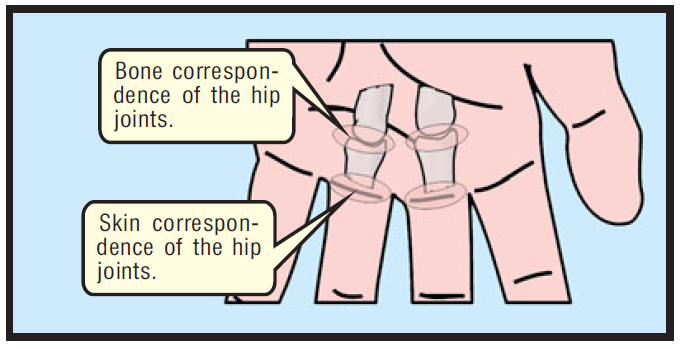
SKIN AND BONE CORRESPONDENCE 7
SKIN AND BONE CORRESPONDENCE
The correspondence systems are not located only on the skin. They are three-dimensional like the body and include the entire hands and feet tissues. Because of that there is a certain difference in the position of the correspondence zones of the organs and tissues that lie deeper in the body and these that are close to the skin. In the first case, as a reference point by the defining of the correspondence zones serve the hand and feet bone-structures (bone correspondence), and in the second one – the hand and feet skin flaps (skin corre-spondence).
Example: The correspondence zone of the groin flaps (the skin in front of the hip joints) coincides with the skin flaps under the middle and fourth finger. However, the zone of the hip joints, which are deeper situated, coincides with the knuckles of the third phalanges of these two fingers.
When the disease’s focus is deeply located the pain points should be searched as man proceeds from the bone correspondence. When the disease is close to the skin or on it the pain points should be searched on the basis of the skin correspondence.
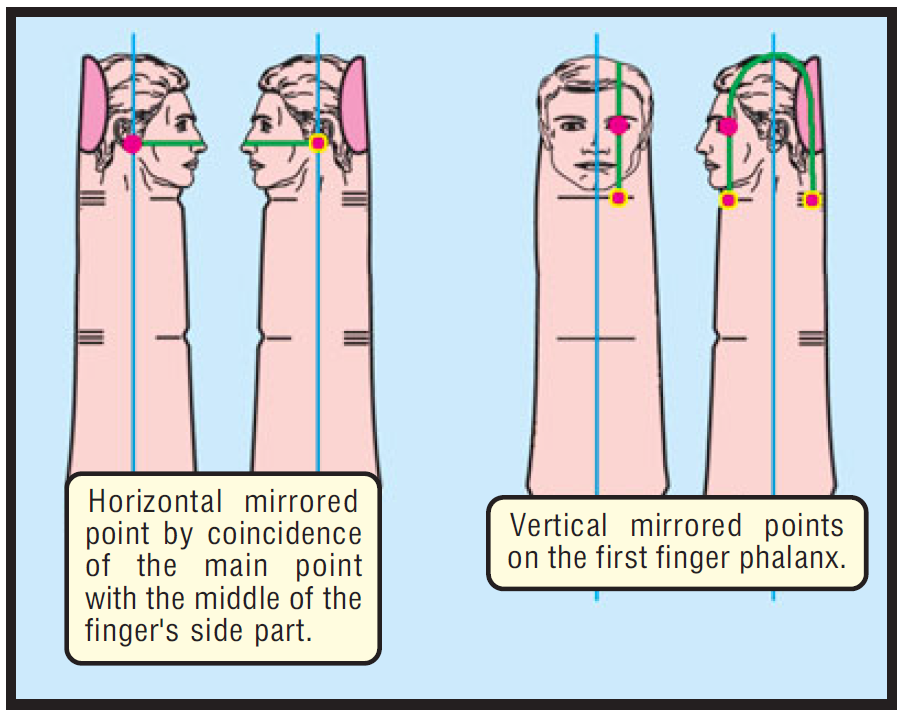
MIRRORED PAIN POINTS 8
MIRRORED PAIN POINTS
When some organ or part of the body gets diseased in the correspondence zones on the hands and feet, save the main pain points, also appear the so-called mirrored pain points appear. We will describe part of these points but we’ll save you the theoretical ground for their appearance. We will concentrate on the mirrored points, located on the fingers because their defining is very easy. Furthermore we consider that to know and to use them is enough for the practical objectives of our manual.
We’ll consider a concrete example with a correspondence zone of the heart in the “Insect” system on one of the fingers. If the heart is diseased in the correspondence zone appears a pain sujok point appears. Let’s draw a vertical line through this point, parallel to the symmetry axis of the correspondence system, to its intersection with the finger knuckles under and above the point. At the intersection point of this line with the knuckles always appear the so-called vertical mirrored pain points appears.
They are not as painful as the main su jok point but are always in the knuckles under and above it.

Now let’s draw a horizontal line, perpendicular to the symmetry axis, through the main su jok point from the example to its intersection with the side part middle of the finger from its both sides. Pain points always appear there, too, called horizontal mirrored points..
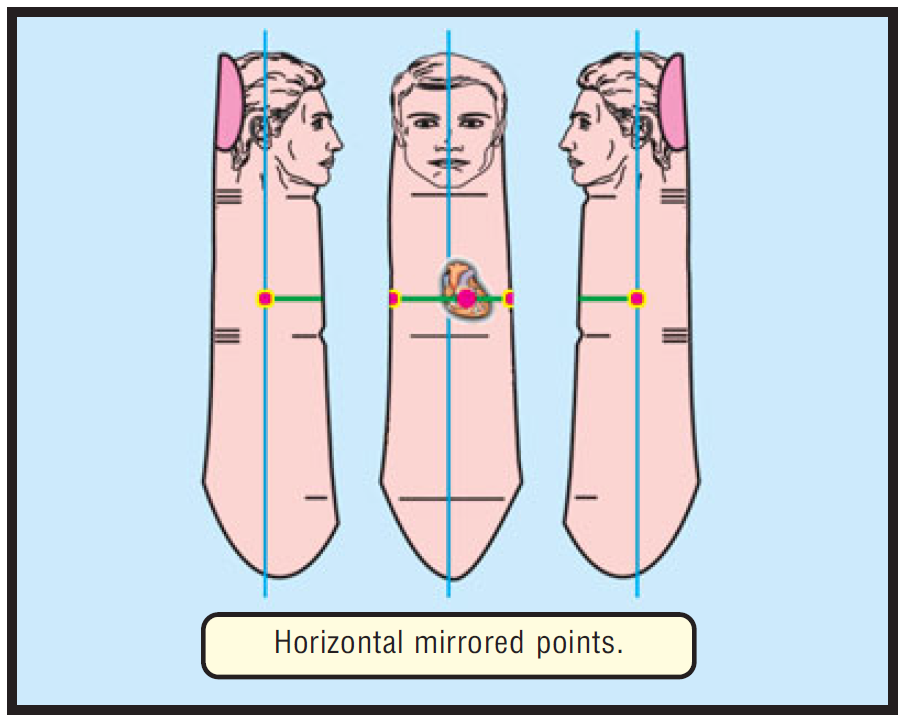
Vertical and horizontal mirrored points appear around the main pain points in all correspondence zones of the diseased organ in the “Insect” system and in the part of the Main system, located on the fingers. They are of major importance for the quick course of the healing process. The stimulation of the main pain point in combination with the vertical or horizontal mirrored pain points leads to an immediate result. The use of these points is especially effective when the patient wants to cure large affected areas. For example – pneumonia, having affected the two lungs.
We find the vertical mirrored points on the middle and third phalanges of the fingers in the way we described above, as we draw a vertical line, perpendicular to the symmetry axis of the correspondence system, to its intersection with the knuckles under and above the pain point.
The things are different by the vertical mirrored points on the first phalanx of the fingers because in this case we don’t have a knuckle, located above the main pain point. Here we locate one of the vertical mirrored points as we draw a vertical line to its intersection with the knuckle under the main pain point. The other mirrored point lies on the same knuckle but on the other side of the finger. We locate it as we produce the vertical line to the finger’s tip and drop it on its other side to its intersection with the knuckle.
We find the horizontal mirrored points on all finger phalanges in the same way, described above, as we draw a horizontal line until it intersects the middle of the fingers’ side parts. An isolated case is the coincidence of the main pain point with the middle of the fingers’ side part. Then the mirrored horizontal point is only one and it is located on the other side of the finger, against the main pain point..



IRREFUTABILITY OF THE CORRESPONDENCE SYSTEMS 9
IRREFUTABILITY OF THE CORRESPONDENCE SYSTEMS
The existence of the correspondence systems can be ascertained in a very simple way. It’s enough to try to find pain su jok points in the correspondence zones of a diseased organ. Such points are always to be found. When the organ is sound these pain points are missing.
It is so easy and simple to check the existence, location’s accuracy and effectiveness of the correspondence systems that there is no room for doubt, controversies and discussions. The correctness of the correspondence zones is flatly proved through the practice of thousands of people, using the su jok therapy – professionally or for self-treatment.
Note: The illustrations of the Main system and the “Insect” correspondence system, published above, are of illustrative nature. The exact topography of each correspondence zone is represented in the prescription guide.

DISEASES THAT CAN BE TREATED WITH SU JOK 11
Su jok can be used for treatment of each disease if you know where its focus is. Besides, the disease’s nature is not important.
You must know for sure which the diseased organ is, where the focus of the disease is. Then only, you can define correctly the correspondence zone and can stimulate the healing su jok points, which have appeared there. For that reason with su jok you can cure diseases with an exact address. The nature of these diseases is not important. The healing impulses directed to the diseased organ cure it no matter what the disease is.
From the point of view of the su jok therapy it makes no difference if your stomach suffers from ulcer, gastritis or something else. The healing impulses created through the stimulation of the pain su jok points attack the disease regardless of its nature.

TREATMENT PROCEDURES 12
TREATMENT PROCEDURES
The treatment procedure with the su jok therapy is not complicated and is the same for each person regardless of the disease’s nature. It includes selection of the correspondence zones of the diseased organ that will be used, location of the pain su jok points in these zones and their stimulation. In view of the fact that the correspondence zones are situated in the same manner by all people, for each one could be very easy to find them, without help, on his/ her hands and feet, to choose several of them, to find the pain points that have appeared there and to cure him/herself with high efficiency, stimulating these points.
And so – the technology and manipulations constituting the treatment procedure in su jok are not complicated and are the same for all people regardless of the disease’s nature. They are as follows:
- Selection of the correspondence zones of the diseased organ on hands and feet.
- Location of the pain points in the correspondence zones.
- Creating of a healing impulse through stimulation of the pain points.

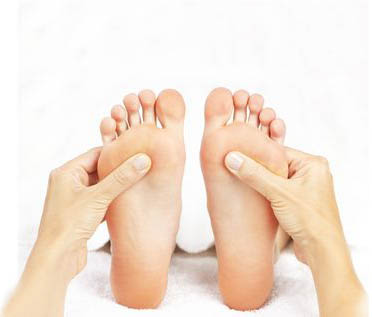
SU JOK THERAPY PRACTICE 10
SU JOK THERAPY PRACTICE
You can use su jok without a problem parallel with other treatment which is controlled by a doctor.
In this case practice su jok therapy without worries – it will considerably shorten the time needed for the healing. Remember that the su jok therapy doesn’t have contra-indications and secondary effects. It can’t do any harm to you. Su jok can be used parallel with every other way of treatment. Thus the disease will be cured faster and the quantities of the taken drugs (if you take any) and the damages caused by them will be smaller.
You can practise su jok without medical control with banal, acute or chronic diseases.
Many illnesses do not necessarily require medical assistance. For instance a slight chill or cold can be stopped quickly through massage of the pain su jok points in the correspondence zones of the throat and nose.
The obstinate chronic diseases that give you trou¬ble and that you know well – for example pain in a joint, can be also treated single-handed.
You can use su jok as a first aid by emergen¬cies before someone from the medical services arrives.
The su jok therapy has no contra-indications and secondary effects and can be used by everyone without health risk. But there are some conditions with which this therapy will be not sufficiently effective or won’t be wisely to be practised.
Su jok therapy must not be practised:
► During or after excessive alcohol or drug use.
► With a strong fatigue, insufficient sleep or starvation.
► When the disease is acute and is not medically diagnosed (unless as a first aid).
► Immediately after finishing a lavish meal.
► During the last three months of the pregnancy.

SELECTION OF THE CORRESPONDENCE ZONES 13
SELECTION OF THE CORRESPONDENCE ZONES
The first and most important condition for a successful single-handed practice of su jok is the correct medical diagnosis.
Before you start practising su jok, you have to know for sure what your disease is and which the diseased organ is. If you don’t have the opportunity the nature of your disease to be determined medically, you can follow your sensations but in principle you should not start a su jok therapy treatment without exact medical diagnosis of the disease. Otherwise it is possible you to go wrong and to stimulate the zones of other organ, not the diseased organ’s zones. This won’t do any harm to you but neither will help. This way you will be disappointed of the method without a reason. That is why it is so important a specialist to examine you and to define the exact location of the disease. You should not (save you are forced by the circumstances) try to find the focus of the disease on your own, judging by the location of the pain you feel. Pain is a symptom that could be misleading.
Example: You have pains in your waist and you may decide that you have problems with the spinal column but in fact your pain could be caused by a kidneys disease. It is evident that if you stimulate pain points in a correspondence zone of the spinal column instead of a zone of the kidneys, you won’t have success.
After the diseased organ or part of the body is defined you must choose several of its correspondence zones which you will use for its treatment.
Each organ or part of the body has numerous correspondence zones on the hands and feet. The brain for instance, has forty correspondence zones. To achieve a healing effect it is not necessary to stimulate the pain points in all correspondence zones. Depending on the seriousness of the disease it is enough to choose from one to four of them as you have in mind the following:
- The correspondence zones in the Main system and in the “Insect” correspondence system have the same effectiveness.
- The correspondence zones on the feet are more efficient than the zones on the hands.
- The primary correspondence zones are more efficient than the secondary correspondence zones.
- The combination of zones on the hands with zones on the feet is more efficient than the combination of zones only on the hands or only on the feet.
- When a large body area is affected it is better the smaller correspondence zones in the “Insect” system to be used.
Outline the correspondence zones that you’ll use with some harmless colouring agent (marker).
At least in the beginning it is necessary to do this. Thereby you won’t deviate when you look for the pain points in the zone and you’ll find them easier.

ADDITIONAL CORRESPONDENCE ZONES 14
ADDITIONAL CORRESPONDENCE ZONES
Except for the correspondence zones of the diseased organ in the treatment procedure one or two additional correspondence zones of other organs, directly connected with the ill person can be selected and included, which are most likely involved in the pathological process. This is done with more serious, acute and chronic diseases when the result of the pain points’ stimulation in the correspondence zones of the diseased organ is unsatisfactory. In the first place pain points in the correspondence zones of the spinal column and brain should be searched.
ROLE OF THE SPINAL COLUMN
The spinal column is a highway, where information flows from the brain to each part of the body and vice versa. The vertebrae of the spinal column can be compared to highway forks that lead to different organs and parts of the body. By most chronic diseases the affection process includes one or several areas of the spinal column, which are connected to the diseased organ. Thus the normal information link between the brain and the diseased organ is hindered. The regulating functions of the brain are worsened.
We can normalize the ‘brain – diseased organ’ relation and achieve a healing effect, stimulating the pain points that conform to the diseased organ in the correspondence zones of the spine.
The pain points should be searched on this side of the correspondence zones of the spinal column, where the diseased organ is located.
Note: When we talk about vertebrae of the spinal column we have in mind all tissues (segments of spinal cord, spinal- cerebral nerves etc.) adjoining the respective vertebra.
ROLE OF THE BRAIN
The brain controls all organs and systems of the body. If an organ gets diseased in the correspondence zones of the brain a pain point appears. This point conforms to the brain area, which corresponds with the diseased organ. The stimulation of this point makes the healing effect more powerful.
Normally several pain points can be found in the correspondence zones of the brain. Since it is difficult to define which of these points is connected with the diseased organ the most painful one is to be chosen.
With especially serious and insusceptible to medical treatment diseases, save on the correspondence zones of the spinal column and brain, pain points should also be searched in the correspondence zones of organs that are connected with the diseased organ and are probably a link from the pathological chain. But in view of the fact that the defining of these organs requires some medical competence it is necessary (if you are not competent) to consult a specialist.
If you don’t have the possibility for consultation just check the correspondence zones of all main internal organs and choose one or two of them in which you find the most painful points or areas.
Example: If you suffer from inflammation of the bladder it is probably due to a kidneys inflammation. It is necessary to search for pain points in the areas of the kidneys too.

CONNECTION OF THE ORGANS AND BODY PARTS WITH THE SPINE 15
CONNECTION OF THE ORGANS AND BODY PARTS WITH THE SPINE
Here we name some of the vertebrae in whose correspondence zones you should look for pain points if the organ or the part of the body, they are connected with, has a chronic disease. You can find the position of the vertebrae zones and reference notes on their relation to the body parts in the prescription guide.
With the letter C are indicated the cervical vertebrae, with T – the thoracic vertebrae, with L – the lumbar vertebrae, with S – the sacral vertebrae. The number, next to the letter, is the vertebra’s number. The dash between the indication of two vertebrae means that they and all vertebrae between them correspond with the respective organ or part of the body.
Lungs and bronchi: C3-C4, T3-T9
Heart, ascending aorta: C3-C4 from the left, T1-T8
Gullet: T3-T5
Stomach: C3-C4, T6-T9
Ascending colon of the large intestine: T9-L1
Appendix: C3-C4, T11-T12 from the right
Descending colon of the large intestine: C3-C4
Rectum: T11-T12, L1-L2
Liver and gall-bladder: C3-C4, T6-T10 from the right Pancreas: C3-C4, T7-T9 from the left Kidneys and ureters: C4, T10-L2 Bladder: T11-L3, S2-S4 Uterus: T10-L3
Ovaries and uterine tubes: T10-L3 Testicles: T12-L3 Mammary glands: T4-T6
Nape: C2
Cervix: C3-C4
Arm: C6-C7
Forearm: C6-C7, T1
Armpit: C5-C7, T1-T3
Shoulder: C4-C5, T1-T3
Collar-bone: C4
Shoulder girdle: C4-C5, T1
Thorax and back to the diaphragm: C4, T1-T8
Abdominal area: T9-T12, L1, S1
Back below the diaphragm: T9-T12, L1-L5
Outer side of the thigh: L2-L5, S1
Inner side of the thigh: L2-L4, S2-S3
Outer side of the shank: L4-L5, S1
Inner side of the shank: L4, S1-S2
Foot: L4-L5, S1-S2

LOCATION OF THE PAIN SU JOK POINTS 16
2. LOCATION OF THE PAIN SU JOK POINTS
You can find the pain su jok points in the correspondence zones with a simple instrument, called diagnostic probe or with a proper object at hand.
The diagnostic probe serves for location and massage of the pain points on the hand and foot. It is a stick made of metal, plastic or wood, about ten centimetres in length. Its both ends are spherical, with roundness 2-4 mm. One of the spheres is with larger diameter and is used on the soft parts of the hand. The smaller sphere is used on the areas, where the bones are close to the skin.
If you don’t have a probe, you can use a match, the thin end of a thermometer or other appropriate object at hand with a rounded tip and 2-3 mm in diameter. With a little practice you could locate the su jok points even with a nail.
♦ Look for the pain points as you carefully go through the outlined correspondence zones with the diagnostic probe.
Go through the zone as you press the probe vertically, with the same intensity and move it slightly. Move the probe consecutively and methodically – as if you mow a lawn, with a step equal to the diameter of its tip. Don’t leave an unchecked area. The pain points are small and could be easily missed. That is why it is very important to explore the zone methodically, not just to wander about it randomly.
When you look for the pain points pay attention on the following:
- The probe’s pressure should not be too intensive, because then you will feel a pain everywhere you press. Start with a slight pressure.
- It is possible after you go through the zone for the first time not to find a pain point. Then repeat, as you make the pressure stronger and change the angle of pressure.
- In the knuckles area look for the pain su jok points by bent and stretched fingers (toes) trying to check as deep as possible the space between the knuckles.
- In the area of the soft tissues (for example the palm) use the big end of the probe and more intensive pressure so you can “feel” the bones underneath.
- You can also explore the zone as you “slide” the probe on the skin. When its tip goes over a pain point you will feel that clearly.
- In the hand and foot areas where the skin is close to the bones, for example the upper side of the fingers, you can easily locate the pain points as you roll over them the side part of the probe.
- If it is a large zone, first explore it with a strong vertical pressure of the thumb. Normally the area, where the pain points are located, is tender. Then check this spot with a probe very thoroughly.
For instance, if your gastric ulcer is in the upper part of your stomach, look for pain points in the upper part of its correspondence zone. Or if you have pains in the middle part of the thigh – look for pain points in the middle of its correspondence zone etc.
► When the disease’s focus is close to the skin or on it, look for the pain points proceeding from the skin correspondence, and when it is in the internal organs and in the deeper located tissues follow the bone correspondence.

Finally you will locate one or several pain points. If there are several points – one of them will be most painful. When this point is pressed, the pain is sharp, sometimes unbearable. The pain is more intensive by acute diseases and slighter by chronic ones.
Mark the located points and outline the most painful one.
Sometimes the pain points are so close to each other that they become one and form larger pain area. Normally the middle of the area is most painful and corresponds to the most painful point.
The epicentre, the focus of the disease is projected on the most painful point. Its stimulation attacks this focus directly and has a powerful healing effect. We can compare the other not so painful points with the glowing embers lying around the fireplace. When we try to work on them, to put them out, this will only abate the warmth of the fire but won’t extinguish it because the focus will be still untouched. For that reason the right determination of the most painful point is so important.
You can find out if you have defined the most painful point correctly after you stimulate it experimentally. The stimulation of this point brings comfort practically always and immediately.
Note: The outlining of the most powerful point is of great importance when the stimulation is with needles, massage, seeds or magnets, because in this case it is absolutely necessary not to miss the point. By stimulation with moxa the exact location is not so essential because in practice all pain points in the warmed area are stimulated simultaneously.
If you don’t find pain points in the correspondence zones of a diseased organ is quite possible your disease to be inaccurately diagnosed. There are ALWAYS pain points in the correspondence zones of a diseased organ. In case the diagnose is beyond doubt it is possible the pain points to be located deep under bone structures that hinder their easy location, or in the soft parts of the hand under thick tissue layer. It is possible that you haven’t found these points due to lack of experience.
The pain su jok points have also a diagnostic value. If you find pain points located in the same way in all correspondence zones of an organ in the both correspondence systems – the Main and “Insect”, it is quite possible this organ to be diseased.
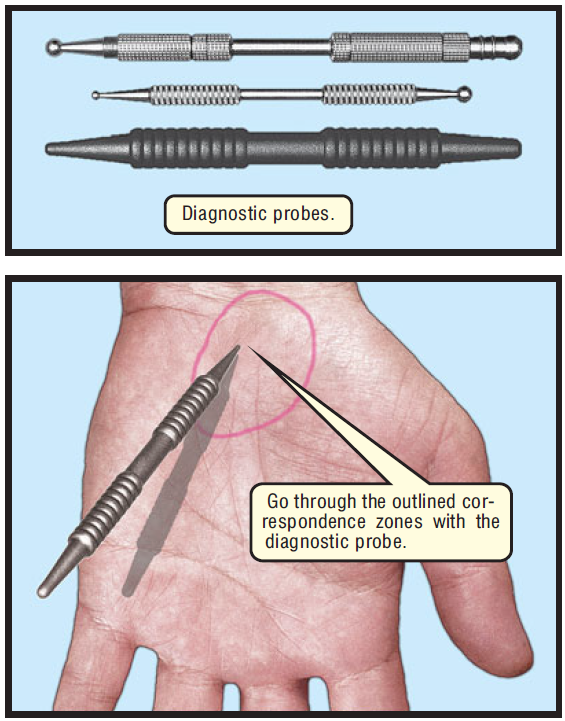



STIMULATION OF THE PAIN POINTS 17
To create a healing impulse and to achieve a healing effect it is necessary the su jok points to be stimulated. In essence the su jok points are acupuncture ones. To activate them are used traditional ways of stimulation that are also practiced in the traditional acupuncture. Most often are used:
Moxa stimulation (moxa);
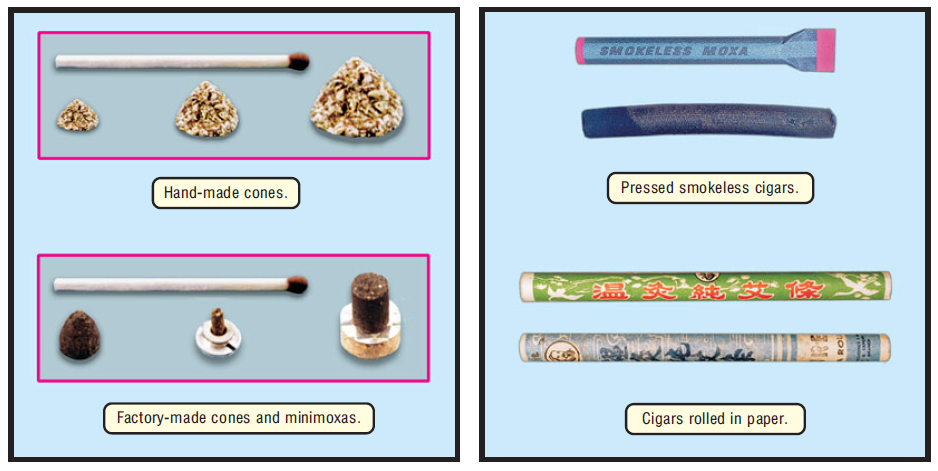



Cold stimulation (criotherapy);
The cold stimulation is quite unpopular but is necessary in particular cases. It can be used instead of moxa when the disease includes high temperature of the whole body or of the diseased organ, or when the weather is too hot. In these cases the moxa use is not recommended. It’s better to put ice on the traditional or su jok points. For the purpose you can use ice made in pieces and put in a nylon bag, trying to lay it only on the traditional point or on the area with the pain su jok points.
You can also use a test-tube or other appropriate glass vessel filled with ice.
Special plastic forms, which can be used for making of ice “cigars” – cigar-shaped ice pieces, are also manufactured.
You can make an ice “cigar” by yourself as you freeze water in an appropriate tubular plastic bottle.
The duration of the process is the same as for the moxa stimulation.
Su jok needle stimulation;


Combined stimulation with needles and moxa;



Stimulation by Massage 17
Various kinds of massage;
The massage of the pain su jok points leads to quick therapeutic results and is very suitable for self-treatment. Its stimulation hasn’t got such powerful effect on the su jok points as the moxa and the needles, but when practised properly and intensively enough, it has the same effectiveness.
The massage in the su jok therapy is much more efficient than the popular point massage in the traditional acupuncture. To show good results the point massage should be done by a well-trained acupuncture or point massage specialist. When practised for self-treatment the result is disappointing.
In contrast to the point massage, the single-handed massage in su jok therapy allows successful healing and a special previous training for the points’ selection and their treatment is not needed.
The pain su jok points can be massaged in several ways:
- Diagnostic probe massage.
- Seed massage (seed-therapy).
- General massage with various massagers.
- Finger massage.
- Magnetic stars massage.
The massage can be done with a diagnostic probe but also with other appropriate object that is available, even with a nail.
Press the pain su jok point with the probe’s tip and rotate it a little so to place it in the “centre” of the point – the spot with the most violent pain.
When you set the probe in the centre of the pain point, change its angle to the point to find the direction with the most intensive sensation.
Keep the probe steady in the centre of the point.
The pressure should be strong enough so you can feel an intensive pain – as much as you can take. After a while the pain will abate, it will almost fade away.
When the pain from the point pressure abates tangibly, start massaging it with light rotary movements of the probe.
Make the rotary movements by turns in both directions: 3-4 movements clockwise and 3-4 movements counterclockwise. The massage is finished when the pain fades away and you feel warmth in the point. Usually 3 to 5 minutes are enough.
Depending on where the points are located – close



SEED MASSAGE (SEED-THERAPY) 18
SEED MASSAGE (SEED-THERAPY) 18
For seed-therapy all kind of seeds with different shape and size can be used, leading to quality massage of the pain points. It is preferable round seeds to be used.
Very appropriate for seed-therapy is the pepper. Its seeds are with a relief surface and the massage with them is excellent. Further more the pepper has an additional warming up effect on the skin.
Put on the pain points you have found a seed of some plant – pepper, a pit of cherry or some other fruit, millet, soy-bean etc. and fix it with a piece of adhesive tape.
Bigger seeds are put on the soft parts of the hand or foot – for instance on the palm or arch.
Smaller seeds are put where the bones are close to the skin – for example on the upper part of the fingers.
If you have the chance use “live” seeds. These are seeds that can sprout. The live seeds’ energy exchange with the pain point is very active and this furthers the more successful passing off of the treatment process.
It is very important the seeds to be placed exactly on the pain points. When you press them, you should feel pain. If they are not on the right spot, you won’t feel pain and there will be no healing effect.
The adhesive tape should be of high quality and your hands should be well dried, this is a guarantee for a stable fixation. If the weather is hot and your skin is sweating, dry it with talc or kid powder.
When the pain points are more or form a pain area, make a “carpet” of seeds and cover the whole area with it.
Make the carpet of seeds arranging the seeds on an even surface in the needed shape and press them slightly with the sticky side of a piece of adhesive tape. Then the adhesive tape with the seeds is placed on the pain area and is additionally fixed with a bigger piece of sticking plaster if necessary.
The carpet of seeds should not be bigger than the pain area.
On every three-four hours massage the fixed with adhesive tape seeds for one-two minutes, using pressure and rotary movements of the thumb.
You should massage for 1-2 minutes, not just press the seeds from time to time. When you do the massage, look at your watch. Don’t estimate the time intuitively. Because the massage is quite painful, twenty-odd seconds may seem to you like more than two minutes and you can stop before a powerful enough healing impulse is created.
Be careful not to wait too much, because a blister can appear!
When you want to massage with one seed only, move the skin together with the seed to place it on the pain point and then start massaging.
When you massage using a carpet of seeds, change the centre of the thumb pressure until you feel the most painful area under the carpet. Focus the massage on this area.
Change the seeds after 24 hours.
It is considered that for 24 hours the seeds emit their energy and that’s why they must be changed. Besides, they become soft because of the skin moisture.
It is very convenient to put seeds on the feet. There they can’t be noticed and don’t focus attention. In addition, the shoes press them and when you walk they make constant, intensive massage. Thus it is not necessary for you to massage the points on every three- four hours.
Choose seeds that do not hurt the leg but can be felt by walking.



GENERAL MASSAGE WITH MASSAGERS 19
Even when the disease is at its first stage and we don’t suspect this, in the correspondence zones of the diseased organ pain points appear. If at this stage we stimulate them, we can block the disease’s progress. In this case a less intensive and not so long stimulation is needed than for a disease discovered at a later stage. Such a stimulation, which can stop the disease in the very beginning of its progress, is the general massage of the correspondence systems on the hands and feet, with specially developed for the su jok therapy massagers.
The su jok massagers are made to massage intensively the skin and the tissues under it in number of various small point areas. For prophylaxis and to keep fit it is necessary the massage with these tools to be made every day or every second day. The regular use of su jok massagers stimulates all pain points in all correspondence zones, even when they appear, and attack the diseases right from their start. The massage has a tonic and stabilizing effect on the entire organism.
By treatment of more serious diseases the use of su jok massagers can’t replace the methods of stimulation, which we described so far, but it could be used as an additional method. Furthermore it can be used in addition to any kind of medication – drug, herbal etc., speeding up the process.
We must notice that sometimes through general massage with su jok massagers amazing results are achieved with obstinate chronic diseases.
MASSAGE WITH FINGERS
The correspondence zones respond to the disease not only with the appearing of pain points but also with a change in the state of the tissue, which forms them.
If you run your fingers along your hands and feet, you can find tense muscles, hard or sensitive areas. Very useful is their strong, intensive massage with fingers till a complete warming up and relaxing of the tissues is achieved.
Usually the massage is made with a thumb or forefinger, with a violent pressure and slow rotary movements. You could make the massage more effective, if you dub your skin with some oil or cream in advance. The massage has a prophylactic, strengthening and healing effect.
GENERAL MASSAGE WITH MASSAGERS
The most widespread massagers, which are used for general massage of the correspondence systems, are:
- A massage ring.
- A massage spiral.
- A massage cylinder.

A MASSAGE RING
The massage ring is made in a special way from twisted flexible steel wires. It is mainly used for a finger massage. In view of the fact that the entire body is projected on the fingers, their massage has a clear strengthening effect.
The massage is done through very fast and intensive rolling of the ring, back and forth, along the length of the massaged finger.
By rolling the ring on the finger, the pain areas and points in the correspondence zones of a diseased organ can be easily felt. In this case an intensive massage is possible only of the above-mentioned areas and the thumb of the hand, directing the ring, should press the ring harder exactly on this place. This applies to the massage with a massage spiral and cylinder too.
A MASSAGE SPIRAL
The massage spiral and massage ring are made in the same way. The spiral is used for general massage of the hands. It aims a high quality massage of the entire hands. The massage is done through intensive and fast rolling over of the spiral between the palms or between a palm and the upper side of the other hand.
A MASSAGE CYLINDER
The massage cylinder is made of metal or plastics. It is aimed for massage of the hands and feet. Its stimulation is very strong. It is rolled over fast and intensively between the palms, between a palm and the upper side of the hand, between a palm and the upper part of the foot, also it is rolled only with the foot.
The massage cylinder is advisable for people with a coarse skin, who need more effective massage than this made with the massage rings and spirals.
If necessary, with the cylinder not only the hands and feet can be efficiently massaged but also other body areas.
MAGNETIC STARS MASSAGE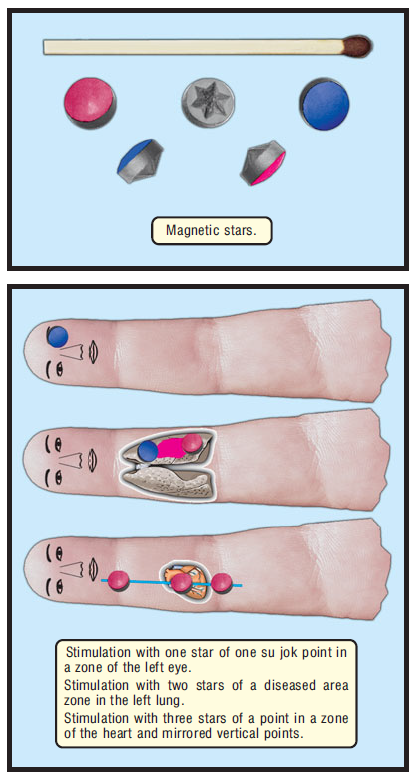
Except for seeds various artificial stimulators are used in the su jok therapy. Most widespread are the magnetic stars. They are with a diameter of about 6 mm and are made of ferromagnetic alloy. Their relief lower part is star-shaped. They are placed on the pain points and fixed with an adhesive tape, like the seeds.
The magnetic stars stimulation is a kind of massage method for stimulation, but the massage is also combined with the stimulation of the magnetic field, which tangibly increases the healing effect.
Two kinds of magnetic stars are manufactured. The first are with a north pole from the relief side (with a blue or white cap). The other ones are with a south pole from the relief side (red or yellow cap).
There are different ways for using the magnetic stars. Here you’ll get acquainted with three of them.
► To place one magnetic star on a main pain point.
► To place two magnetic stars on a projection of an affected area.
► To place three magnetic stars on one main and two mirrored points.
STIMULATION WITH ONE MAGNETIC STAR
One magnetic star is placed on the main pain point, when there is a small, localized focus of the disease.
STIMULATION WITH TWO MAGNETIC STARS
Two magnetic stars are used with larger affected areas. On two pain points, in two opposite ends of the projection of the affected area, two magnetic stars with a different polarity are placed.
STIMULATION WITH THREE MAGNETIC STARS
Three magnetic stars are mainly used on the fin¬gers. One magnetic star is placed on a main su jok point and two, with the same polarity, on two mirrored points – vertical and horizontal.
POLARITY SELECTION
When one or three stars are used, there is a relative approach to their polarity selection:
► If the disease is characterized by excess of ener¬gy – inflammatory, hyperfunction (too great activity), magnetic stars with a south pole (red or yellow cap) are placed on the skin. Placed this way, they suppress, damp down.
► When the disease is characterized by lack of energy – atrophic, hypo function (insufficient energy), spasm, magnetic stars with a north pole (blue or white cap) are placed on the skin. Placed this way, they tone, warm up.
Often it is very difficult to define the nature of the disease – if it is characterized by excess or lack of energy. That’s why in practice is adopted the so called application method for polarity selection of the magnetic stars is adopted. Initially magnetic stars are placed with a south pole to the skin (red or yellow). After a few minutes (sometimes several hours) you feel that your state of health changes. If you feel that the symptoms worsen (for example worse cough by affected lung, more violent pain) the reason is that the polarity changes.
When two magnetic stars with a different polarity are used in the both ends of an affected area, there is no rule for their selection (from which side the south and from which side the north pole). Here the application method is used. The stars are placed by your wish. Their polarity changes, when the condition gets worse..
The magnetic stars are placed for several hours a day (for 24 hours is possible too). On each three-four hours the su jok points should be massaged with them for 1-2 minutes. The next day the stars are moved to another correspondence zone of the diseased organ.
Attention! You must be very careful when using magnetic stars (and magnets), if you are sensitive to magnetic field. If the polarity change leads to discomfort you’d better use seeds.
MAGNET STIMULATIONAn effective method for stimulation of the pain su jok points and areas is the magnet stimulation. In contrast to the magnetic stars here we don’t use massage. The relief magnets stimulate only with their magnetic field.
The magnets create an energy flow in the correspon-dence zone of the diseased organ, which rectifies, normalizes its energy state.
The vector of the magnetic field is directed from the north to the south pole. Through selection of its direction against the pain su jok point or area the diseased organs and tissues can be relaxed or stimulated, cooled or warmed up.
Three kinds of magnets are used:
► Point magnets.
► Ring-shaped magnets.
► Magnetic pointers.
The three kinds of magnets are characterized by mark¬ing as it is by the magnetic stars. Blue and white colour of the cap means that the north pole is below (warms, tones), red and yellow – the south pole is below (cools, sedates). A non-standard colouring of the magnets is also possible. In this case a manufacturer manual concerning the polarity is needed.
POINT MAGNETS
The point magnets are round-shaped, with a diameter of about 6 millimetres. Usually they are white on the one side, and yellow – on the other. They are used in the same way as the magnetic stars. A regular massage is not done with them because here the stimulation comes only from the magnetic field.
RING-SHAPED MAGNETS
The ring-shaped magnets consist of two magnets, a point magnet in the middle and a magnetic ring – around it.
The ring-shaped magnets are fixed with an adhesive tape on a pain points or area. They are placed for several hours (at the most 24), after that they are moved on pain points in other correspondence zone of the diseased organ.
The ring-shaped magnets, placed with a yellow point magnet and a white ring above, suppress, calm down, cool (inflammation, high temperature, excess).
The ring-shaped magnets, placed with a white point magnet and a yellow ring above, tone, stimulate, warm up (paresis, bad irrigation, insufficiency).
The polarity selection is done depending on the disease’s nature. The application method is used when the disease is hard to be diagnosed, to be defined.
Ring-shaped magnets with several magnetic rings with alternating polarity are also manufactured. Depending on the correspondence zone’s size of the affected area the rings can be added and removed and so the size of the stimulated area to be regulated.
MAGNETIC POINTERS
The magnetic pointers look like elongated rectangles. In the first end of the magnetic pointer is the north pole and in the other – the south. Thus the vector of the magnetic field is directed along the length of the magnetic pointer, from the white to the yellow end of the pointer.
The magnetic pointers create a pointed energy flow in the correspondence zones. For example by chronic constipation a magnetic pointer can be placed in the correspondence zone of the large intestine in such a way that the direction of the magnetic vector to coincide with the direction of the food. With diarrhea the direction of the magnetic vector must be against the direction of the food.
Magnetic pointers can be used instead of two point magnets in the both ends of the affected area. They can be arranged one after another and so to make the stimulation line longer.
The magnetic pointers are fixed with an adhesive tape for several hours (at the most 24), after that they are moved on pain points in other correspondence zone. The selection of the vector’s direction of the magnetic field is usually done with the help of the application method.

PRINCIPLES OF THE SU JOK THERAPY
CORRESPONDENCE SYSTEMS AND ZONES
The human body is a complex mechanism where all the parts work in constant close interrelation. To function correctly they continuously interchange information. In every part of the body, without interruption, comes in information about all other parts and at the same time information about each part’s condition is emitted. This interchange of information, as well as the storage of the received information, is carried out by the so-called correspondence systems.
The correspondence systems are informative, power producing projections of the organism located on all independent parts of the body. They look like reduced images of the human body, so deformed that to build in the form of the appropriate body part. Correspondence systems are built in the ears, head, feet, hands, internal organs, tongue, eyebrows and all other parts of the body, even in each cell.
Since each correspondence system is a reduced image of the organism, all the organs, all parts of the body are represented in it. The zones (the areas) of the correspondence systems, which correspond to the particular body organs, are called correspondence zones. Each organ and part of the body has their own correspondence zone in all correspondence systems. For example, the stomach has a zone of correspondence in the systems of correspondence, located on the ears, eyes, feet and in all other correspondence systems.
The correspondence systems are in continuous information interchange. They contain full information about the organism, about its present condition. Save for the fact that they have information about the human organism, they actively stimulate its state of health. The mechanism for this stimulation is the following:
When an organ gets diseased, in all other correspondence systems a signal concerning this is received. The correspondence systems react as one or more miniature spherical formations in the correspondence zone tissue of the diseased organ, are formed in them. When pressed they are painful and are subjectively felt as pain points. Further, we will refer to them in the same way.
If the kidney gets diseased, pain points appear in its correspondence zones, located on the ears, hands, feet, tongue, nose, fingers and all other independent parts of the body. The same happens with a disease of the stomach, eyes, liver and every other organ or part of the body.
In everyday life man continuously stimulates, accidentally and chaotically, one or another correspondence system and the pain points that have appeared there as a result of disease. When you put a hat, you press part of the correspondence zones, located on the head. When you walk, you massage the correspondence zones on the feet. When you work, you stimulate the correspondence zones on the hands etc.
As a result of this stimulation, the pain points in the correspondence zones generate healing impulses, directed to the diseased organ. In this way, healing impulses flow from different parts of the body, from different correspondence systems, to the diseased organ. They activate complex regulating mechanisms, which fight against the disease.
The healing impulses, created in consequence of the human everyday activity, are formed accidentally and chaotically. They are sufficient for the preventive keeping fit when there are some slight deviations in the state of health. But these impulses may not exist by sedentary way of living or may not be sufficient by more severe disorder. Then the disease gets worse. Therefore to heal ourselves, when we are seriously ill, it is necessary to create powerful enough healing impulses through an intentional and directed stimulation of the pain points in some of the correspondence systems.
This question emerges immediately – which of the numerous correspondence systems are most efficient and can be used most successfully for that purpose? Which of them include the organism reserves most effectively? The experience gained till now, indicated that these are the correspondence systems located on independent parts, which have the strongest resemblance to the human body and create healing impulses most often. Such independent parts are the hands and the feet. They have an amazing structural resemblance, a similarity to the human body structure. In addition, they get most often into contact with the environment thus creating healing impulses most often. Nature wisely took care of things and the most often created impulses are the most powerful and effective ones. Because of that, the healing impulses generated in the correspondence systems located on the hands and feet are far more powerful and effective than the impulses generated in the most of the other correspondence systems.
The sujok therapy has entirely been created on the basis of the correspondence systems located on the hands and feet. It consists of two levels. The first level is easy to use by people without medical education and includes several healing correspondence systems. From practical point of view the most important are two of them:
Main correspondence system;
“Insect” correspondence system.
Here we will confine ourselves to the presentation of these two correspondence systems that are suitable and sufficient for unaided practice.
The second high level of sujok is a healing method based on metaphysical ground. It is more complicated and for its learning more careful preparation in the acupuncture sphere is needed.
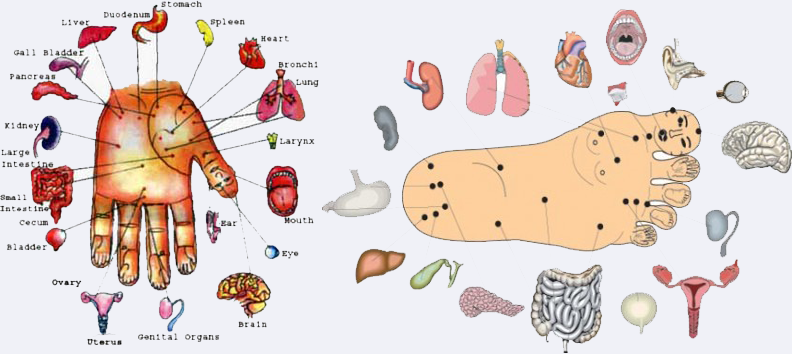
No comments:
Post a Comment